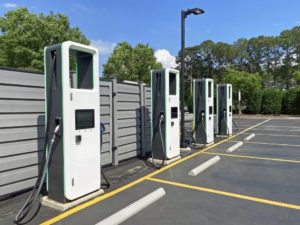In November, Congress passed and President Biden signed into law the massive infrastructure bill. That legislation designates a whopping $7.5 billion toward building an electric vehicle charging infrastructure.
Congress outlined broad guidelines how these taxpayer funds must be spent, including: $2.5 billion to build EV charging facilities along “designated alternative fuel corridors” and another $2.5 billion “will fund the Charging and Fueling Infrastructure Program.” These funds will be distributed via grants to cities and states.

It appears that in their haste to throw gobs of tax dollars towards incentivizing Americans to buy really expensive electric vehicles, Congress forgot some of their own Interstate Highway System rules and regulations. You see, back in 1960 after thousands of miles of the new nationwide interstate highway system opened for traffic, Congress passed another law forbidding any commercial activity at the newly constructed rest areas that appear along the Interstate highways. The rest area ban includes gas stations, restaurants and now, presumably, EV charging facilities. An interesting exception was made for toll roads in that 1960 legislation: toll roads were allowed to keep their traveler-friendly roadside amenities, many of which exist still today.
Several state transportation departments have unsuccessfully lobbied Congress to allow EV charging stations at their Interstate rest areas. After all, it doesn’t make much sense to spend billions of tax dollars to build EV charging stations far away from interstate traffic, like say in Motley, Minnesota. However, that is exactly what has and will be happening.
Even if the state DOTs were successful in obtaining permission from Congress to construct EV charging stations at Interstate highway rest areas, think about this: a Level 2 EV charger (which would cost $5000-$6000 to construct) provides “about 25 miles of propulsion energy per hour of charging.” In other words, the average EV charge would take several hours using a Level 2 charger while the driver is stranded at rest area with no food, coffee or safe and warm place to gather while waiting for their vehicle to charge.
On the other hand, an ambitious state DoT could construct a state network of EV DC fast chargers. They can provide an adequate recharge in less than one hour. Their downfall? Each EV charger costs $110,000 or more, meaning that the billions appropriated by Congress won’t build quite as much of a network of charging stations as EV enthusiasts had hoped.
To sort things out, President Biden announced that he is doing what Washington does best: establish several join committees and commissions to study and advise how best to expand the government-built charging stations necessary so that in eight years, 50% of all vehicles sold in America will be electric.
Over 100 years ago, (1905 to be exact) what is believed to be the first filling station opened in St. Louis and was operated by the American Gasoline Company. Within a decade, there were 500,000 privately owned vehicles filling up their tanks at other private “filling stations.” There were no official government commissions necessary to figure out where to build these service stations – the private market provided that valuable service. Fifty years later when the Interstate Highway System began construction, private service station owner adapted and built service stations, restaurants and other amenities close to that system with no government subsidies, no government task force plans and with the fear that someday the prohibition against rest area amenities would be overturned.
Today, there are more than 250 million vehicles on the road and 40 million of them fill up their gasoline tanks each day at a service station. Instead, these privately owned facilities pay state, local, and federal taxes that support our extensive system of roads.
It’s sad to watch the massive government waste happening (Buy Electric!) where an American elite tries to build a market for a product (electric vehicles) most Americans don’t want and can’t afford.